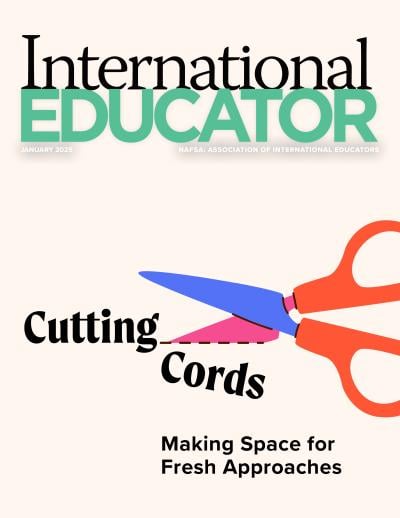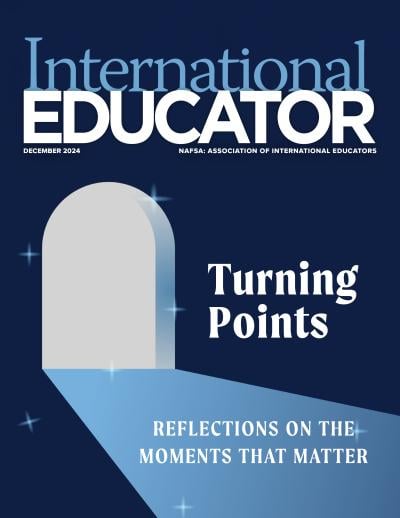Take Action: The Impact of Displacement in Higher Education Access

Over the past year, the world has faced challenges that some of us may never have imagined beyond a Hollywood movie or a best-selling book. With the spread of the COVID-19 pandemic, a magnifying glass has now been fixed on various weaknesses within the global infrastructure.
Weaknesses within international higher education have not been exempt. From lack of travel options to scarce resources and funding, higher education has been adjusting to the new norm of virtual and hybrid models of learning environments, as well as continued staff reductions.
Refugees and other displaced populations are among the many who were already facing uphill battles to find security and safety, along with a lack of educational opportunities. The lack of access to basic human needs, as well as higher education, will continue to spread and multiply among refugee populations unless we take a serious look at our own behaviors, policies, and intentions as an international education community.
Now is a moment in time for the international higher education community to have truthful conversations about innovation, collaboration, and restructuring policies through a lens of compassion and empathy.
The world continues to combat COVID-19 through advances in science, technology, and public health initiatives. I believe now is a moment in time for the international higher education community to have truthful conversations about innovation, collaboration, and restructuring policies through a lens of compassion and empathy. What better place to start than with the more than 80 million forcibly displaced people worldwide, of which only 3 percent have access to higher education?
Challenges Displaced Populations Face
There is little argument that forceful displacement from one’s home can be a lifelong traumatic experience. A great deal of data, research, and personal accounts put together by organizations and think tanks such as the United Nations High Commissioner for Refugees (UNHCR), Migration Policy Institute, International Rescue Committee, and others detail the challenges refugees face in their search for a more stable life. Movement within Afghanistan, Syria, Yemen, and other conflict zones, as well as border crossings into the unknown, continue to introduce risks as families must leave behind homes, friends, and heirlooms.
Once people are displaced, they must decide whether to stay within their home country or attempt to flee. For those who stay, displaced in their own country, many must contend with scarce food, loss of employment, and being caught up in a conflict. Living conditions worsen, and disruption of education can become a common occurrence.
Those who are forced to drift onward face even more upheaval. Whether over land, sea, or air, threats can include dangerous travel conditions, hunger, extortion, and violence. Those who are lucky enough to have money with them might lose it to smugglers with real or false offers of protection and transportation. Others may be forced into refugee camps or detention centers, where they might languish for months or even years. Families often become separated during these forced migrations. Xenophobic and racist policies can lead to countries shutting down their borders. Employment opportunities may not exist where refugees end up, and they may have to keep moving. All of these and a host of other obstacles can easily turn into life-threatening circumstances.
Even if refugees make it through their long and arduous journey, more daunting barriers, both physical and emotional, await them at borders. Confusing, ever-changing laws, border patrols, and severe environmental conditions all contribute to the unsafe and often complex process of attempting to seek refuge or asylum in the United States and elsewhere.
Where Does the Higher Education Community Begin?
One of the first aims of refugees is to secure a sense of stability through employment. This can be a difficult task given the frequent harsh treatment and legal complexities shown to newcomers in a given country. However, recognizing international academic credentials and creating pathways to educational opportunities are both immensely helpful ways higher education professionals can facilitate meaningful employment. As part of the higher education community, we can help refugees by removing as many unnecessary hurdles as possible for those who wish to further their education.
Of course, all experiences and situations are different, but there are some frequent similarities among refugees seeking educational opportunities. In 2015, Educational Credential Evaluators (ECE) conducted research to find what displaced populations need most in the context of credential evaluation. Initially, the research team thought the lack of academic documents would be the largest concern. Documentation challenges can create a host of problems for higher education administrators. When fleeing a conflict zone or persecution, grabbing a high school diploma or a university transcript is not usually a family’s top priority. Documents can be lost along the way, or they may be unverifiable or poor quality, if available at all. This can leave higher education professionals feeling uncertain about admissions decisions and powerless to help.
As part of the higher education community, we can help refugees by removing as many unnecessary hurdles as possible for those who wish to further their education.
Somewhat unsurprisingly, ECE found that the primary challenge for refugees is, in fact, cost. Even if refugees have managed to grab their academic documents and keep them safe, or have access to them through services such as Article 26 Backpack, what can these individuals do to become licensed to work in their field of choice or continue their education? It is reasonable to presume that concerns about cost go beyond just credential evaluation within the context of higher education. Resources may exist, but due to language barriers and confusion, many refugees may not know what is available to them.
Higher education professionals, refugee resettlement agencies, and other nonprofit organizations should extend their expertise, resources, and assistance to refugees who seek educational and work opportunities.
Higher Education Community Solutions
Though it may seem daunting for international education professionals to tackle some of these major issues, there are still many ways we can create a more welcoming and accessible educational environment for refugees. One small example, based on ECE’s research, is the ECE® Aid initiative, which provides evaluation reports free of charge to vulnerable and displaced populations. The key to success in this model has been strategic collaboration with not only higher education institutions but also resettlement agencies and job placement organizations that work directly with immigrants and refugees. By offering a service in our area of expertise, credential evaluation, and collaborating with other organizations with their own areas of expertise—visa applications, housing, employment, and language classes, to name a few—team members have been able to share resources and knowledge to help those most in need.
The key to success has been strategic collaboration with not only higher education institutions but also resettlement agencies and job placement organizations that work directly with immigrants and refugees.
Higher education as a community should look candidly at what it takes to provide a more equitable pathway to resettlement and access to education. The higher education community plays a crucial role in leading by example and must become advocates for lasting change.
In the short term, application fees as well as book and housing costs should be paid for through university and community support and scholarships. Long-term solutions to ensure better access to higher education should include pathways to improving language skills, mental health care, and food and housing security. Equally vital for the success of refugees in higher education is engagement with on- and off-campus communities and organizations. One of the many ways to accomplish this is by forming a student or campus group to bring together volunteers and resources for refugees and reach out to local organizations and resettlement agencies already engaged in immigrant rights. Without community support, refugees can experience continued trauma if they do not feel welcome.
Reflection and Resources
With just 3 percent of refugees having access to higher education, how many potential students—and their potential contributions to innovations in technology, health care, the arts, business, and other areas—are being left behind? Ignoring the disruption of education on such a scale could have profound consequences for the world. In response, the UNHCR launched in 2019 the 15by30 target with a goal to "achieve enrolment of 15 percent of college-eligible refugees in tertiary or connected higher education programmes in host and third countries" by 2030.
This is not a Hollywood movie, and this is not an abstract story of some distant person from far away. These individuals and their families are real and are looking for hope in our very own cities and neighborhoods.
Many resources already exist for international educators to assist vulnerable student populations. As previously mentioned, ECE® Aid was developed to provide fee waivers for credential evaluation services. Just as ECE looked to its areas of expertise to help the cause, international educators should do the same, starting with their own department or team, school, and community to see what small part they can play. It is essential to listen to the refugee, asylee, and immigrant communities in one’s area to understand what they need. Never assume you know what is best for refugees.
A few other resources are helpful when considering different approaches. An American Association of Collegiate Registrars and Admissions Officers report, Inclusive Admissions Policies for Displaced and Vulnerable Students, is a great place to start for admissions offices. Similarly, IIE PEER is a wonderful resource for refugees and other displaced students looking for scholarships and opportunities to access education. Organizations and educational institutions can also feature on their websites and promotional materials any scholarships and other services they offer to refugees and displaced populations.
My hope is that the field will become more actively engaged in refugees’ quest for higher education together as a community of educators, international education professionals, community organizations, businesses, foundations, federal and state governments, and nongovernmental organizations. This is not a Hollywood movie, and this is not an abstract story of some distant person from far away. These individuals and their families are real and are looking for hope in our very own cities and neighborhoods. Let us bolster and carry out our mission as a community to actively help from our corner of higher education and make positive, lasting, structural change together. •
NAFSA Resources
- Social Justice and International Education, "Integrating Refugees into U.S. Higher Education" chapter and "The Fight for Refugee Children’s Education" essay
About International Educator
International Educator is NAFSA’s flagship publication and has been published continually since 1990. As a record of the association and the field of international education, IE includes articles on a variety of topics, trends, and issues facing NAFSA members and their work.
From in-depth features to interviews with thought leaders and columns tailored to NAFSA’s knowledge communities, IE provides must-read context and analysis to those working around the globe to advance international education and exchange.
About NAFSA
NAFSA: Association of International Educators is the world's largest nonprofit association dedicated to international education and exchange. NAFSA serves the needs of more than 10,000 members and international educators worldwide at more than 3,500 institutions, in over 150 countries.
NAFSA membership provides you with unmatched access to best-in-class programs, critical updates, and resources to professionalize your practice. Members gain unrivaled opportunities to partner with experienced international education leaders.













